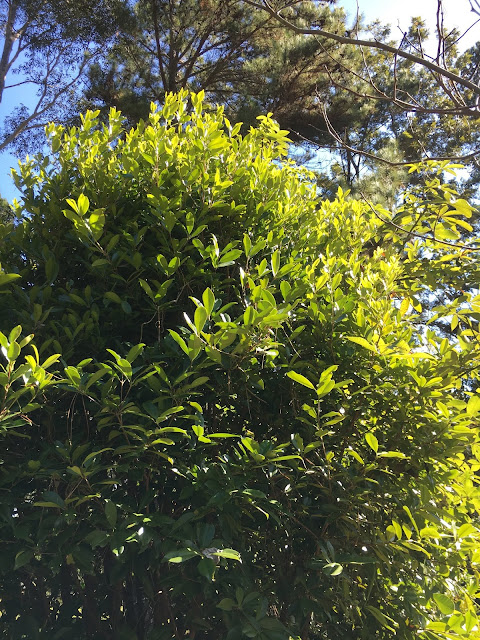A walk around the food forest in the bright, midwinter (late July) sun is always interesting. Citrus are providing buckets of fruit. The odd Custard Apple still hangs on and we collect the pumpkins before the bush rats can attack them. As far as our plants are concerned Spring is almost here and the peaches are coming into flower.
 |
| Pumpkin in tree |
Taro,
Chili, Tithonia, Ragweed (Crassocephalum crepioides), all thriving in
midwinter on a sunny north facing slope in southern hemisphere in a warm
temperate climate.
Our
Hog Plum (Ambarella) is in fruit and we made a curry. Sugar and salt
and much boiling was required and we ended up with a sweet curry. Perhaps we need to lop this tree to keep its fruit in reach and so it will not shade other trees.
 |
| Mexican Weeping Bamboo |
Mexican Weeping Bamboo is surely the most attractive bamboo of all. It is perfect on the wall of our small dam
 |
| Edible Colocasia |
Taro surviving some near zero temperatures.
 |
| Tropical Peach |
A Tropical Peach is the first to burst into flower.
 |
| Tithonia |
Mexican Sun Flower provides plenty of cut and drop mulch but we must remove the seed heads.
 |
| Peach Palm |
Our three years in the ground Peach Palm is thriving despite the midwinter cold. It loves its well drained position.
This attractive, fast growing palm reaching 12-15m produces clusters
of peach-like fruit, which have a sweet and nutty flavour when eaten
after cooking. The palm is native to Central and South America and the
fruit are often sold at fruit markets.
Daleys Fruit Tree Nursery
 |
| Pitomba |
A Pitomba is growing much more slowly than the above Peach Palm although planted at the same time.
![Pitomba Fruits harvested By Barbara Dieu [CC BY 2.0 (https://creativecommons.org/licenses/by/2.0/)] From Flickr https://flic.kr/p/6K5pah](https://plant.daleysfruit.com.au/trees/s/Pitomba-2013.jpeg)
An excellent ornamental shrub. The pitomba produces bright
orange-yellow fruit with soft, melting, juicy flesh with a highly
aromatic slightly acid flavour. They are good eaten fresh or made into
jelly and preserves. Taste comparable to an apricot. Very slow growing,
hence suitable as a dwarf fruit tree."
Daleys Fruit Tree Nursery
 |
| Amla |
This Amla was also planted at the same time and is alteady a metre tall. It was attacked by borer but seems to have recovered well. I hope the fruit will be useful despite their reputed sour taste.
"Phyllanthus
emblica, also known as emblic, emblic myrobalan, myrobalan, Indian
gooseberry, Malacca tree, or amla from Sanskrit amalaki is a deciduous
tree of the family Phyllanthaceae. It is known for its edible fruit of
the same name.
Wikipedia"
"The taste of Indian emblic is sour, bitter and astringent, and it is
quite fibrous. In India, it is common to eat emblic steeped in salt
water and red chilli powder to make the sour fruits palatable"
Wikipedia
Our Grumichamas seem made for this climate despite their South American origins.They (a black species and an orange species) reliably provide sweet, small fruit every year.
 |
| Gulf Gold Plum |
A Gulf Gold Plum will be next to flower.This variety of plum has been bred to require low chilling hours, a necessity for our milder winters.
 |
| A weedy Cassia but is it edible? |
Here are two cassias I am trying to identify to see if one of them is edible. Sicklepod (Senna Obtusifolia) is said by some authorities in Wikipedia to have edible leaves. The above cassia is a Tropical Rainforest cassia from Queensland.
 |
| Tree Fern |
We love our self sown Tree ferns.
Our Valencia Orange is laden with fruit that it will hold well into summer with luck. All of our citrus are laden. Our Cumquat is best stewed with sugar to make a sweet but tart dressing for dessert.
![Pitomba Fruits harvested By Barbara Dieu [CC BY 2.0 (https://creativecommons.org/licenses/by/2.0/)] From Flickr https://flic.kr/p/6K5pah](https://plant.daleysfruit.com.au/trees/s/Pitomba-2013.jpeg)







![Pitomba Fruits harvested By Barbara Dieu [CC BY 2.0 (https://creativecommons.org/licenses/by/2.0/)] From Flickr https://flic.kr/p/6K5pah](https://plant.daleysfruit.com.au/trees/s/Pitomba-2013.jpeg)










No comments:
Post a Comment